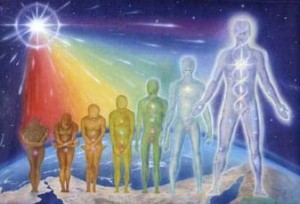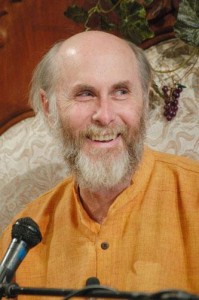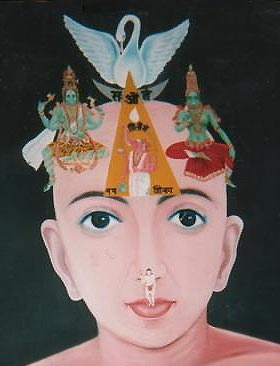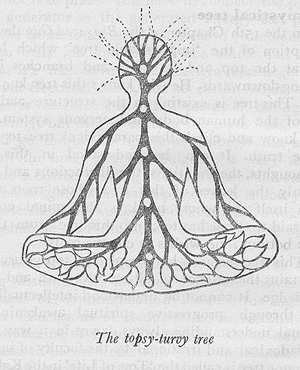Yoga
Meditation, Health, Strength & Energy

FUNCTIONAL SPIRITUALITY
>> An introduction to the value of spirituality for management <<
by Raja Deekshithar
NISCINTANA MEDITATION
Meditation is not only for monks or sanyasins. It is also especially designed for people who live a normal human life, and who struggle with its realities. It will give strength and energy, and can be used to gain answers and solutions for the problems that face us during our life.
We can attain the peace of our most inner Self by preventing the chaos of the mind. What we gain from meditation is clarity of mind, focus, steadiness, peace and harmony. Our thoughts sway here and there. The demands of today create pressures and disharmony. The result is hectic en restless mind. We identify with this restless mind. But our essence, our Self, is quiet and peaceful. The solution is to stay in our centre. The stress and tension will vanish. The practice of yoga will take our mind to the calmness at centre of the Self. Like the bird soaring through the sky. Aiming towards the right landing in the centre of its attention. The practice directs our awareness towards the centre of our being. Doubt, inertia and sickness are the obstacles to our search for peace and harmony. Despair and stress lead to pain and irregular breathing.
The reward of yoga is the dissolution of pain and doubt. It gives clarity of mind. Internal steadiness; Self awareness and focus; Happiness; And a strong and healthy body.
A Hindu view of evolution

:: CULTURE, SPIRITUALITY & LIFESTYLE ::
>> „A Hindu view of evolution“ <<
by David Frawley
Evolution and Science
Modern science recognizes an evolution of form in the world of nature as the dominant movement of life. It notes how the bodies of different creatures adapt over time, becoming more complex and sophisticated through succeeding generations, with new species arising that demonstrate important advances in structure and function over what went before them.
From the beginning of life on Earth with a chemical soup that resulted in single cell organisms to the current state of the planet dominated by intelligent life, science has portrayed an onward march of evolution, albeit with a few detours along the side. Science has outlined a physical or bodily evolution from bacteria and viruses, to plants, animals and human beings.
Tirthas in der Architektur, Ayurveda & Yoga

TIRTHA & DIE HEILIGEN WASSER
> THE TEMPLE OF THE DANCING SHIVA <
>>* NAGESHVARA NATARAJA *<< By Raja Deekshithar
> Shivaganga, the tirtha or sacred water place, the 100 pillars <
> Die Tempelstädte Tamil Nadu, Nataraja-Tempel von Chidambaram <
Das ist einer der ältesten, am meisten verehrten und prächtigsten Tempel in Tamil Nadu. Der Tempel gilt als eine der fünf Tanzhallen Shivas, wo er seinen kosmischen Tanz vollführt. Die anderen vier Tanzhallen sind in Madurai, Tiruvalankadu, Tirunelveli und Kutralam. Nataraja ist der tanzende Shiva, Shiva Nataraja. Shiva steht in der Tanzkunst über allen Göttern, er ist Meister aller 108 Tanzformen. Gemäß der Legende versuchten einige irrgläubige Rishis Shiva durch magische Gesänge zu vernichten. Shiva erkannte die drohende Gefahr und fing an zu tanzen, wodurch die negativen Kräfte der Rishis neutralisiert wurden. Die Rishis wurden sauer und schufen den ignoranten Zwerg Aspama (auch Apasmara Purusha), der sich auf Shiva stürzte. Der böse Zwerg geriet aber bei seinem ersten Angriffsversuch unter einen Fuß des tanzenden Shivas, wodurch ihm das Rückgrat zerbrochen wurde. Die Vernichtung des Zwerges Aspama steht für die Befreiung der Welt von Ignoranz und Unwissenheit. Der böse Dämon, auf dem Shivas rechter Fuß steht, symbolisiert die Unwissenheit, die uns unser Gleichgewicht und Bewußtheit verlieren läßt.
Shivas Freudentanz (Anandatandava) symbolisiert den natürlichen und einen unaufhörlichen Prozeß von Schöpfung, Erhaltung und Zerstörung,- /wie in der Natur (Naturkreislauf)/. Der Tempel wird daher Nataraja-Tempel oder auch Sabhanayaka-Tempel genannt.
Chidambaram ist auch einer der fünf Elemente-Linga-Tempel, hier wird der Raum/Äther/Ether repräsentiert (Aakasa-Stalam).
KAMA – Desire & Spirituality

*Mahabharata Tree – click for full glory*
> Ayurveda System & the 4 Aims <
Dharma ordinarily is a good vocation. Artha is prosperity. Moksha is liberation, and Kama is desire. Written by Yogi Baba Prem (AIVS)
Die Vier Vedischen Antriebskräfte
Of all arts the best is chitra. It gives the fruit of dharma, artha, kama, and moksha. Wherever it is established in a house (or otherwise), it is harbinger of auspiciousness. – Chitrasutra of the Vishnudarmottara, (translation by C.Sivaramamurthy)
Auf der Basis des vedischen Geburts Horoskops können mit Hilfe eines umfassenden Berechnungs-Systems die vier vedischen Antriebskräfte mit der traditionellen Vedischen Astrologie genau berechnet werden. Die vier vedischen Anriebskräfte beschreiben, was Sie motiviert, aktiv zu werden und Dinge in Angriff zu nehmen:
- Dharma (Rechtschaffenheit)
- Artha (Nutzen- und Zweckorientiertheit)
- Kama (Leidenschaft)
- Moksha (Ungebundenheit)
Wenn Sie Ihre dominante vedische Antriebskraft kennen, haben Sie den Schlüssel für energievolles und erfülltes Handeln nach dem Motto „Sei du selbst, dann hast Du Erfolg“.
Die dominante vedische Antriebskraft erklärt, was uns zum handeln motiviert und hilft uns, entsprechend unserer Natur erfolgreich zu sein. Wir verstehen, wie wir „ticken“ und blockieren uns nicht selbst in unseren Handlungen. Die schwächste vedische Antriebskraft gibt uns wertvolle Tipps und Aufschlüsse, was wir achten können, um unser Potential optimaler zu nutzen.
Kundalini the universal event
> Vyayam School & Vedic Foundation <
> VYAYAM –The Oldest Healthy-Energetic Gymnastic <
Kundalini yoga is a part of the tantric tradition. Even though you may have already been introduced to yoga, it is necessary to know something about tantra also. Since ancient times, the wise men have realized that mind can be expanded and that experiences do not necessarily depend on an object.
This means that if somebody is playing music, I can hear it, and if somebody has painted a picture, I can see it, but I can also see if there is no picture, and I can hear if there is no music. This is also a quality of man’s personality which has been ignored in the last 150 to 200 years.
Tantra says that the range of mental experience can be broadened. With the help of the senses, your mind can have an experience based on an object.
There can be an experience within the framework of time, space and object, but there can also be an experience beyond the framework of time, space and object. The second form of experience can happen when the present mind expands beyond its given definitions and borders, and when this experience occurs, energy is released from yourself.
Kundalini & the mystical tree
The mystical tree
In the 15th Chapter of the Bhagavad Gita there is a description of the ‚imperishable tree‘ which has its roots at the top and its trunk and branches below, growing downwards. He who knows this tree knows the truth. This tree is existing in the structure and function of the human body and nervous system.
One must know and climb this paradoxical tree to arrive at the truth. It can be understood in this way: the thoughts, the emotions, the distractions and so on, are only the leaves of this tree whose roots are the brain itself and whose trunk is the spinal column. It is said that one has to climb this tree from the top to the bottom if he wishes to cut the roots.
Yoga Nidra – die Qualität des Schlafes
Skandinavische Yoga und Meditationsschule
in Hannover und im Landhaus Harbergen
www.yogaimzentrum.de
Es ist Swami Satyananda Saraswati, dem Begründer der Bihar School of Yoga (www.yogavision.net) in Munger, Indien, zu verdanken, dass uns heute eine Tiefenentspannung zur Verfügung steht, deren Wirkungen weit über die gewohnte Vorstellung von Entspannung hinaus geht. Er nannte die aus der alten tantrischen Wissenschaft entnommene Methode oder Übung Yoga Nidra.
Durch ein eigenes Erlebnis motiviert, studierte er die tantrischen Schriften. Aus den komplizierten und zeitaufwendigen Praktiken entwickelte er ein neues System, das den heutigen Bedürfnissen angepasst ist, und unabhängig von Alter, Religion oder Kultur von jedem angewendet werden kann.
DAS INNERE DER MERU
Above: A yogi balances Ida and
> Pingala nadis through Kundalini Pranayam <
> Die Shushumna wird auch Meru genannt <
Alle tattvas, die kosmischen Prinzipien sind auch im Körper gelagert. Jedes tattva hat jedoch sein eigenes Wirkungsfeld, eine Region, in der es vorherrscht und von der aus es auf das ganze System einwirkt. Diese Regionen werden in den Tantras die Zentren oder Chakras (Kreise) genannt. Sie sind allerdings keine anatomischen Gebilde, die mit dem groben Auge festgestellt werden können. Es handelt sich vielmehr um subtile Zentren – oder Sitze – des im Körper wirkenden Bewusstseins, Shakti, die entlang der Wirbelsäule (sushumna, meru) gelagert sind; sie beginnen am unteren Ende der Wirbelsäule und erstrecken sich bis hinauf zum Scheitel.
Awakening our senses

Awakening Our Senses
Written by Dr. David Frawley
Featured in Tathaastu Magazine
The five senses are the key instruments that we have in life to perceive the world and make our way within it. How we use them determines how our lives will unfold; whether towards health or disease, creativity or stagnation, enlightenment or ignorance. Learning to use our senses correctly is one of the main skills that we need in order to master our existence and experience life in the optimal manner possible for us.
brihad-aranyaka upanishad I
oder von tantras, Pferden & Bäumen:
neti neti – nicht dies nicht das.
Anbei eine wunderbare Passage der brihad aranyaka upanishad die das höhere Wissen des Mystikers und yogins ausdrückt, über den einen unteilbaren Grund des Seins weiß und der, wie der Seher Yajnavalkya, voller Gewissheit erklärt: Aham brahma asmi (geschrieben aham bhramasmi) „ich bin das Absolute“.
Die älteste unter den frühesten upanishadischen Texten ist die brihad-aryanka-(„Großer Wald“) Upanishad, in der der meditative Pfad noch eng mit Konzepten des Opferrituals verbunden ist.
Veda & Tantra Shastra
> agama shastra, temple worship <
> SIVANANDA – agama, Einführung < > SIVANANDA – tantra yoga <
Santanadharma & Celestial Hierarchy in Christianity
The Veda is the root of all ŚÄ�stras (mūla-śÄ�stra). All others are based on it. The Tantra is spoken of as a fifth Veda. …
When we hear the word ‘Tantra‘, our minds conjure up images of bearded, saffron-clad, ash-smeared faces of ‘aghori babas‘ whose tantric (occult) rituals include eating the flesh of the dead, meditating in cremation grounds and engaging in ‘sacred sex‘. These babas belong to the ‘tamasic‘ branch of Tantra, which is known as ‘Shaakta Pantha‘.
The Tantra Shashtra as defined in our scriptures does not bear any relation to the black arts mentioned above. Our ancients considered Tantra Shashtra as one of the most important Hindu sacred texts and extolled it in their writings. In ancient Hindu scriptures, references to ‘Tantra Shastra‘ and ‘Agama‘ (*)mean the same thing. Let us see what these Agamas tell us.
(*) pronounced ‘Aagama‘ – A as in ‘Arnould‘
Der Weg des YOGA – Was ist Yoga ?
WAS IST YOGA ?
Der Terminus Yoga
Die Bezeichnung yoga stammt etymologisch von der Sanskritwurzel yuj (”zusammenbinden, anschirren, anjochen, ins Joch spannen”) ab und kann im Sinne von “Inswerksetzen, handeln, Praxis, Andacht, Anspannung, Verbindung” verwendet werden.
Das Wesen des Yoga
Die Frage nach dem Zweck und Ziel des Yoga wird von den Yogins und Kennern des Yoga recht unterschiedlich beantwortet. Allgemein wird der Begriff yoga als “Verbindung (mit der Gottheit)” ausgelegt. Solche Deutungen treffen zwar für die urtümliche Form des Yoga, die im Volkstümlichen lebendig blieb, zu, nicht aber für die eigentliche Yoga-Philosophie, wie sie uns von Patanjali überliefert wurde.
Yoga, Ayur-Veda und Siddha Medizin

THE TROUTH ABOUT KUNDALINI

THE TRUTH ABOUT KUNDALINI
by Dr. Udo Szekulics, Mala Rao-Szekulic
“And whosoever will, let him take the water of life freely.” Revelation of John 22, 17
The traditions of India and its neighbouring countries offer more spiritual knowledge than any other region of the world. At home and at school we hardly learn anything about the historical and spiritual background of these areas. As a result, we incur the danger of giving a wrong interpretation to this region’s spiritual tradition by extracting a part of the whole, if we are interested in Eastern wisdom.
*Shiva-Shakti as Kamesvara and Kamesvari, the androgynous form, half male and half female. Pahari School, 18th century Gouache on paper
YOGA, WEG DER NICHT-DUALITÄT
ADVAITA VEDANTA, Karma & Siddhis
> BUCHTIPP I im Juni < > ALLE Bücher von Raphael <
Frage: Wenn man von Yoga oder östlichen Lehren sprechen hört, kommen einem sofort die so genannten Kräfte, die siddhi in den Sinn. Was sind diese Kräfte eigentlich?
Raphael: Diesbezüglich herrscht viel Verwirrung und es gibt zahlreiche Missverständnisse. Abgesehen von der richtigen Bewusstseinsposition gegenüber den verschiedenen Yoga-Arten und den überlieferten Lehren stellen wir fest, dass viele Menschen sogar die Verwirklichung als eine Aneigung der so genannten Kräfte verstehen.







